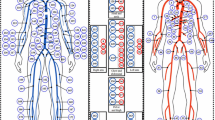Abstract
A mathematical model of the circulatory system based on the principles of venous return is described and applied to the condition of acceleration stress. The model consists of two single compartments representing the pulmonary and systemic portions of the circulatory system. During periods of acceleration stress the pressure in the systemic compartment, which is the upstream driving pressure for venous return, is decreased relative to the pressure at the right atrium due solely to hydrostatic effects. This decreased driving pressure causes a diminished venous return which is reflected in reduced cardiac output and arterial pressure without any changes in arterial resistance. Pressures at other points in the arterial tree, e.g., at eye-level, are related to the arterial pressure at the aortic root by hydrostatic effects.
These concepts are incorporated into equations which are used in an analog computer simulation, the results of which are shown both for a passive system and an active or controlled system. The latter responds to changes in arterial pressure by altering the driving pressure for venous return by means of a change in systemic compliance. The results of this study are compared to experimental tracings obtained from dogs undergoing acceleration stress and discussed in relation to their implications for blood volume shifts and human responses.
Similar content being viewed by others
References
Bartelstone, H. J. Role of the veins in venous return.Circulation Research 1960,8, 1059–1076.
Berne, R. M., andLevy, M. N. Cardiovascular Physiology. Saint Louis, Mo.: The C. V. Mosby Co., 1972.
Beneken, J. E. W., andRideout, V. C. The use of multiple models in cardiovascular system studies: transport and perturbation methods.IEEE Transactions on Biomedical Engineering 1968,BME-15, 281–289.
Boyers, D. G., Cuthbertson, J. C., andLuetscher, J. A. Simulation of the human cardiovascular system: a model with normal responses to change of posture, blood loss, transfusion, and autonomic blockade.Simulation 1972,18, 197–206.
de Freitas, F. M., Faraco, E. Z., de Azevedo, D. F., Zaduchliver, J., andLewin, I. Behavior of normal pulmonary circulation during changes of total blood volume in man.Journal of Clinical Investigations 1965,44, 366–378.
Engelberg, J., andDuBois, A. B. Mechanics of pulmonary circulation in isolated rabbit lungs.American Journal of Physiology 1959,196, 401–414.
Folkow, B., andNeil, E. Circulation. New York: Oxford Univ. Press, 1971.
Grodins, F. S., andBuoncristiani, J. F. General formulation of the cardiovascular control problem—Mathematical models of the mechanical system. In E. B. Reeve and A. C. Guyton (Eds.),Physical Bases of Circulatory Transport: Regulation and Exchange. Philadelphia, Pa.: W. B. Saunders, Co., 1967.
Guyton, A. C. Circulatory Physiology: Cardiac Output and Its Regulation. Philadelphia, Pa.: W. B. Saunders Co., 1963.
Howard, P. The physiology of positive acceleration. In J. A. Gillies (Ed.),A Textbook of Aviation Physiology, New York: Pergamon Press, 1965.
Milnor, W. R., Jose, A. D., andMcGaff, C. J. Pulmonary vascular volume, resistance, and compliance in man,Circulation 1960,22, 130–137.
Permutt, S., andRiley, R. L. Hemodynamics of collapsible vessels with tone: the vascular waterfall.The Journal of Applied Physiology 1963,18, 924–932.
Scher, A. M., Franz, G. N., Ito, C. S., andYoung, A. C. Studies on the carotid sinus reflex. In E. B. Reeve and A. C. Guyton (Eds.),Physical Bases of Circulatory Transport: Regulation and Exchange. Philadelphia, Pa.: W. B. Saunders Co., 1967.
Snyder, M. F., andRideout, V. C. Computer simulation studies of the venous circulation.IEEE Transactions on Biomedical Engineering 1969,BME-16, 325–334.
Wiedeman, M. P. Dimensions of blood vessels from distributing artery to collecting vein.Circulation Research 1963,12, 375–378.
Wood, E. H., Nolan, A. C., Donald, D. E., andCronin, L. Influence of acceleration on pulmonary physiology.Federation Proceedings 1963,22, 1024–1034.
Author information
Authors and Affiliations
Additional information
This work partially funded by Air Force Contract F44620-72-C-0011.
Rights and permissions
About this article
Cite this article
Green, J.F., Miller, N.C. A model describing the response of the circulatory system to acceleration stress. Annals of Biomedical Engineering 1, 455–467 (1973). https://doi.org/10.1007/BF02367269
Issue Date:
DOI: https://doi.org/10.1007/BF02367269




